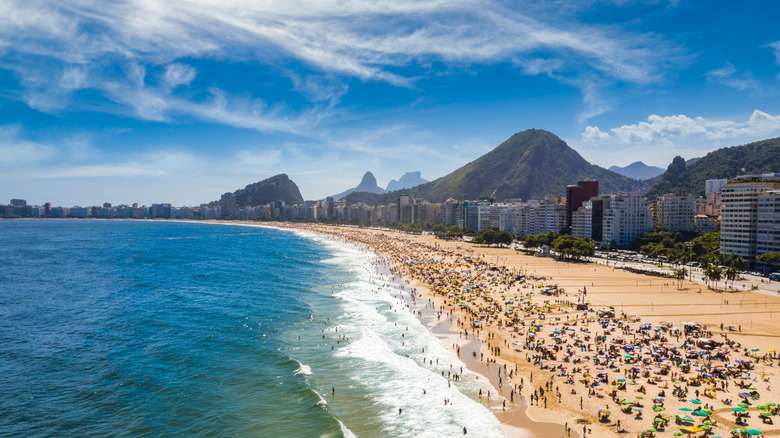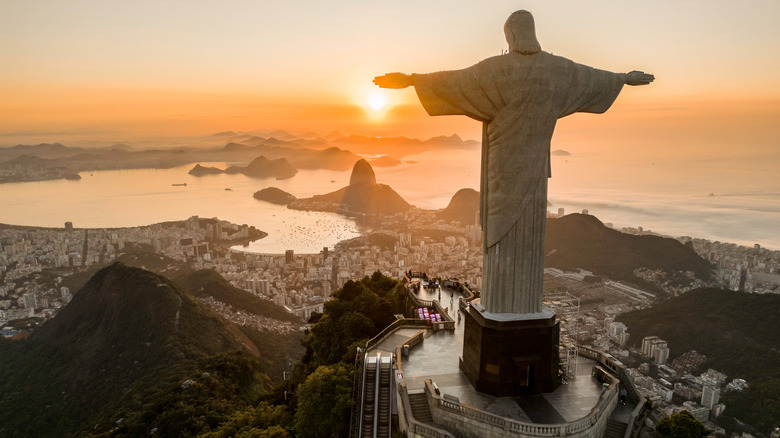One Of The World's Best Urban Parks Is A Scenic Stretch Of Forest Covering Swathes Of A Lively Brazilian City
Rio de Janeiro likely means one thing to many visitors: beaches. The world-famous, long, soft strips of Copacabana and Ipanema beaches are just one layer of the Rio story, though. Towering apartment blocks and hotels run along these beaches, threaded by shopping streets. Beyond them, the rainforest-coated mountains of Tijuca National Park tower over the city. It's this combination of inviting beaches, exciting city life, and tufted rainforest that makes Rio de Janeiro (and Brazil) a tourist haven. That, plus how Tijuca National Park interweaves throughout the city in green patches.
Ranking amongst the top urban parks in the world, Tijuca National Park's all-natural appearance isn't without its irony. The park is a replanted 46-square-mile segment of a once 38,600-square-mile swath of the Atlantic Forest that stretched from northeastern Brazil all the way down to Paraguay and Argentina. Humans had decimated 88% of the forest since the 16th century, and come 1862, Emperor Dom Pedro II ordered the forest around Rio to be replanted. In 1961, Tijuca was deemed a protected national park, and in 2012, it was named a UNESCO World Heritage site.
Tijuca is irregularly shaped, sprawling, and winds directly through its city –– in contrast to other perfectly manicured parks, like New York City's Central Park, which is considered one of the best tourist attractions in America. Not only does the entire expanse afford easy access to numerous hiking options, but also access to a cable car to the peak of Sugarloaf Mountain, a botanical garden dating to 1808, the tiny, pink Mayrink Chapel, and the park's tallest waterfall, Taunay Waterfall. Of course, it contains the magnificent Christ the Redeemer statue, one of the New Seven Wonders of the Modern World sitting on Corcovado Mountain.
Weaving a path through Tijuca National Park's trails and sights
Tijuca National Park could easily take up the larger part of a trip to Rio de Janeiro, or be the entire point of the trip. It's packed full of such a dense array of hiking and mountain climbing options, interesting sites and cultural artifacts that make it feel like a remote and far-flung nature preserve –– not an urban park. Since Tijuca is not only near Rio, but interspersed within and around it, there's no reason to not take advantage of its lush beauty whether you're a hardcore, outdoorsy nature lover or not.
On the hiking and mountain climbing front, Tijuca National Park has a full 101 trails that rise and dip around Rio de Janeiro and the ocean beyond it. Trail difficulties range from the very challenging to the very easy. The 4.5-mile trail to the enormous stone block and peak, Pedra da Gávea, contains some extremely steep sections and a 100-foot sheer wall. The simple and pleasant Lago das Fadas Trail stretches for less than a mile and is good for walking, even jogging, is full of butterflies, turtles, and interesting cave formations. And yes, there are loads of guided tour options for those.
We mentioned other Tijuca highlights like the quaint Mayrink Chapel, the cable car-accessed Sugarloaf Hill, and Taunay Waterfall, but we'd be remiss not to highlight Christ the Redeemer. The gleaming, 98-foot-tall (30 meters) concrete statue of Jesus with his arms outstretched is one of the most easily-recognizable statues in the world. Finished in 1931, it receives over two million visitors a year. Many of those visitors might not realize that the statue is directly inside Tijuca National Park along its southeastern edge.
Building Tijuca National Park into your cityside itinerary
In all likelihood, visitors here will probably hit the beaches, do some shopping and eating, and maybe dip into some lesser known tourist destinations in Rio de Janeiro like Ilha da Gigóia, the lagoon along Rio's southern coast. And while Tijuca National Park weaves through the city and looks totally open and wild, you can only access its three sectors — A, B, and C — at certain points. And, the whole park is only open from 8 a.m. to 5 p.m. (and until 6 p.m. in the summer). Plus, certain areas like Corcovado Mountain and Christ the Redeemer are open until 7 p.m.
Looking at the park's three sectors, Sector A – the smallish, tropical Tijuca Forest — is the easiest to reach. You can access it via Praça Afonso Vizeu by a variety of buses from Rio: 301, 333, 308, 309, and 345. Corcovado Mountain is in Sector B and accessible via buses 583, 584, 569, and 570. Get off at Cosme Velho then take another mode of transportation like bicycle or taxi towards Paineiras. Or if you want a scenic, walkable route, you can walk it from Horto in two-and-a-half hours. Sector C is the hardcore hiking and mountain climbing sector, and reachable through a variety of out-of-the-way means. The aforementioned Pedra da Gávea, for instance, requires personal transportation or a private guide to reach. Depending on the length of your stay and your vacation goals, you can visit whatever you want for a couple hours, a half day, a full day, or whatever else you like, and still be in Rio all the while.


